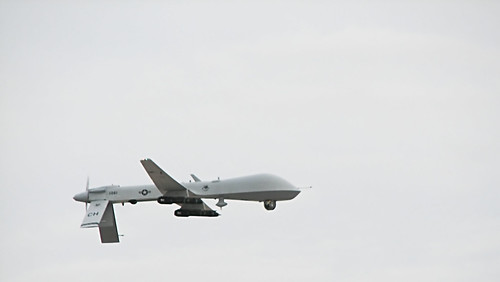Droning On
/
One of the significant elements of the ongoing 'War on Terror' in Afghanistan and Iraq is the continual use of Predator Drones, and other unmanned systems that allow for the remote control of weapons to minimize casualties amongst American forces overseas, while still achieving their objectives. Interestingly, the soldiers who pilot them have been suffering from Post Traumatic Stress Syndrome (PTSD) , essentially experiencing warfare in similar ways, despite operating in vastly different conditions.
According to Military.com: "But that whiplash transition is taking a toll on some of them mentally, and so is the way the unmanned aircraft's cameras enable them to see people getting killed in high-resolution detail, some officers say." (Source) This is further explained at the relatively up close and personal view that soldiers piloting the Drones get of the action, as opposed to that of a fighter pilot, far above the action, who might not see the impact that their actions have.
The situation that these pilots find themselves in bears much resemblance to some of the actions in Orson Scott Card's classic Science Fiction novel, Ender's Game. In this book, Andrew 'Ender' Wiggin, is training aboard an orbital facility, designed to bring out the best tactical leaders in a fight against an alien race. At the last act of the book, Ender has graduated from school, and tasked with what he believes are further training simulations against the aliens, when in reality, he is directing military assets, time and time again against the alien's defenses, destroying them at the end. Upon realizing what he's done, he has a sort of nervous breakdown, and while hailed as a hero, moves to live a secluded life off planet.
Now, in 2010, we are living in what a lot of people would consider a fantastical, science fiction-styled world, where computers fit in the palm of one's hand, and where militaries have the ability to strike against militants and foreign militaries with fairly automated devices. A 2009 book, Wired for War, by P.W. Singer, of the Brookings Institute, looks closely to the developments of military hardware in warfare, and looks to the very nature of automated weapons and the extent to where people will be in control of said weapons. The machines that go to war now are not the machines of science fiction literature and films: they're more like remote controls, with a person 'in the loop' at the end of the communications console, who directs the craft against targets and basic functions. The move to a more robotic system will occur as the human controllers are released from more controls, with a computer that's able to take over more functions. Some robotic systems, such as the ones that are designed to shoot mortars out of the sky, can react much faster than a human operator, and in order to effectively operate, they are more automated. Some drones can largely act on their own, with their mission programmed into them, with a human looking to push the button to start it up.
However, like in Ender's Game, operators are still on the front lines, abit virtually, carrying out their commander's intent and subsequent orders in a way that helps to deliver their mission, much like soldiers on the ground, operating in ways that might not be as appropriate for drones. At the end of the day, however, there is a central mission that needs to be carried out, issued by a commanding officer, whereupon, the details of the mission should be carried out in the most appropriate manner. This often depends upon the quality of the leader at the top, the resources that are available at their disposal, and the abilities of the people underneath them to carry them out. In this way, the story of Ender's Game and that of a Drone Pilot could easily be reconciled with one another. The same can often be said for any other military science fiction book out there, and the quality of the novel or film will not depend upon the technology that is present, but the world surrounding military events.
This is why, when reading about Predator Drones, I'm reminded of the events that take place in Ender's Game. The specific technology, governments and people don't necessarily matter in these contexts, but the framework laid out and put together in a largely rational and logical fashion endures, lasting far longer than technological predictions that will likely date the book. As such, Ender's Game is an interesting read in the science fiction universe, and has applications during the present day. Indeed, a number of these lessons can be applied, no matter the time period and technology present: ancient Roman militaries would act in the same general way that a modern commander would: locate the problem, determine a mission, find the right way to overcome said problem and execute a plan to achieve one's goals.
However, what does change, is the methods in which soldiers interact with the battlefield. In the instance of Drone pilots and Andrew Wiggin, both deal with the realities of war remotely and virtually. Indeed, one of the biggest issues that one might face with operating said machinery would be the emotional impact and power associated with the ability to strike without reprisal. As the battlefield becomes more automated, warfare becomes fare more effective, cleaner, and potentially quicker, at least on the tactical level. Yet, soldiers are still at war.
In the end, Drone warfare is essentially another tool available for military commanders, and as such, the soldiers who operate them will come under the same stresses, conflicts and moral issues as any other soldier assigned to a mission. This circumstances change as soldiers are further removed from the battlefield, but it should be remembered that despite the distance from the actual conflict, there will still be repercussions, as these soldiers fall within far larger strategy and operational plans, and are thus still at war, as has been carried out for thousands of years.

